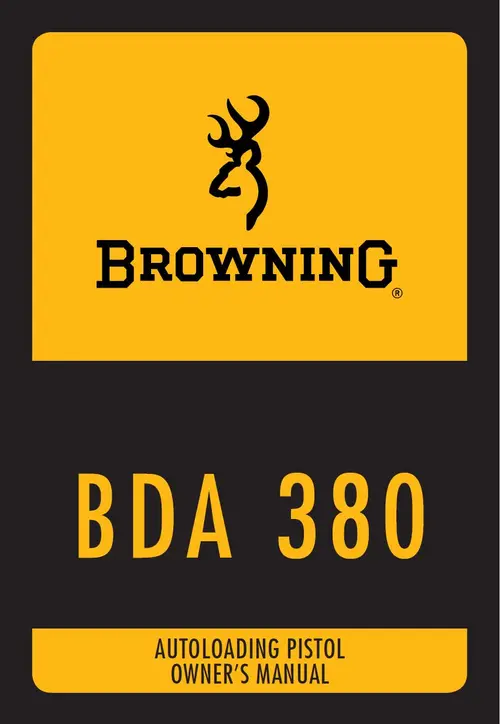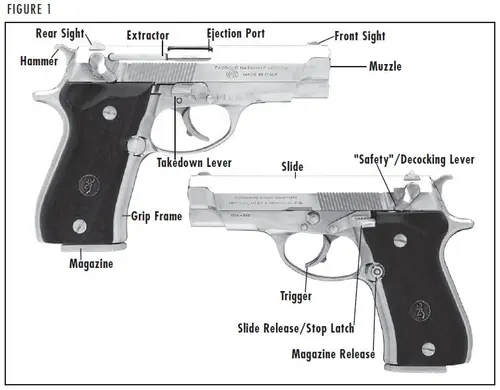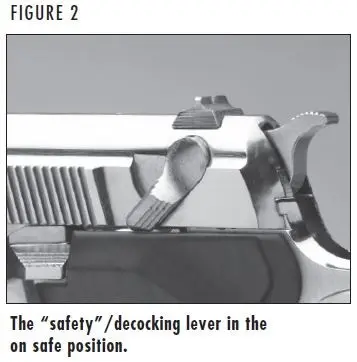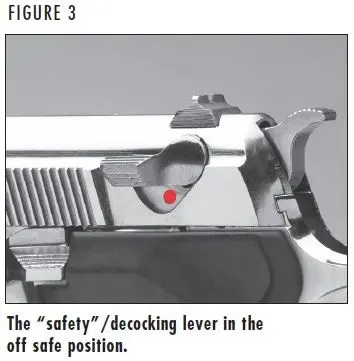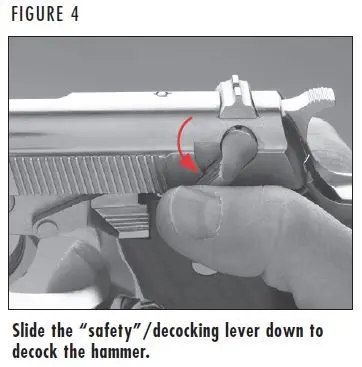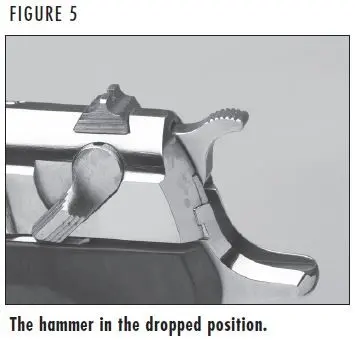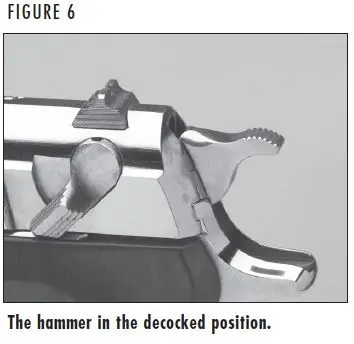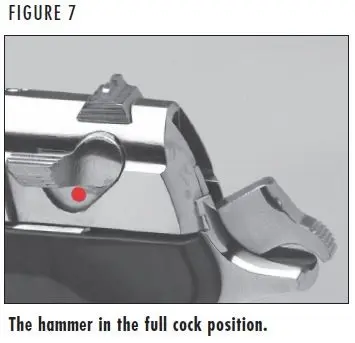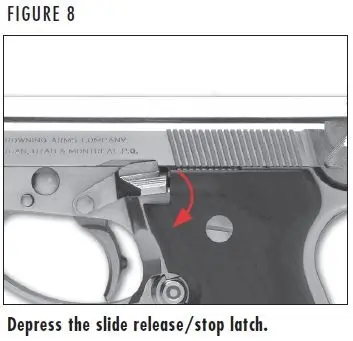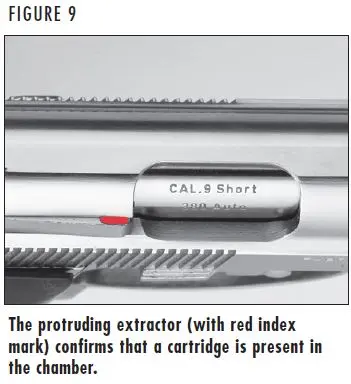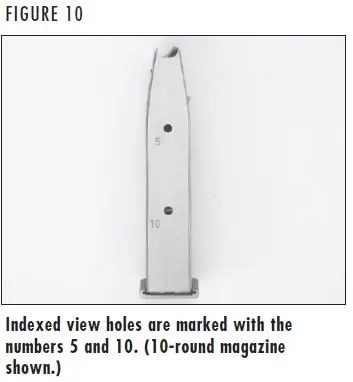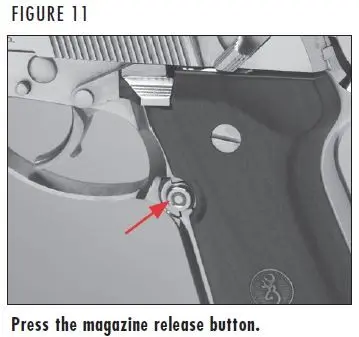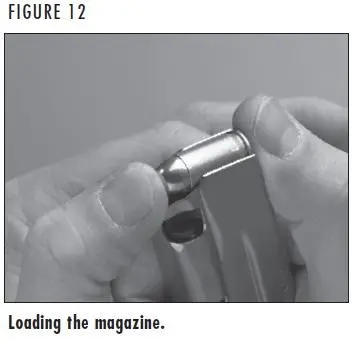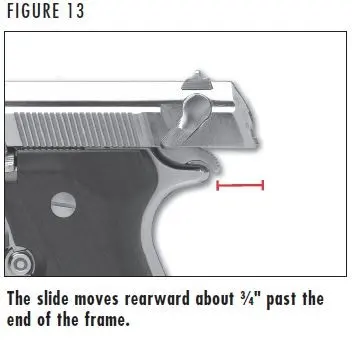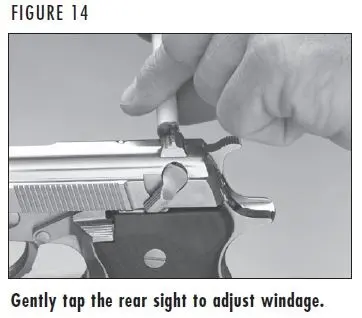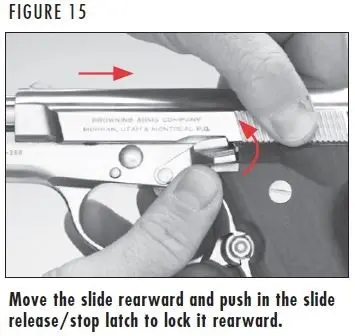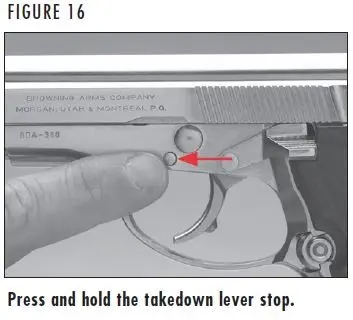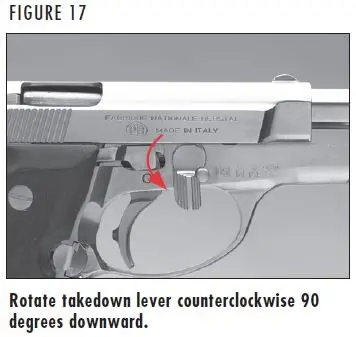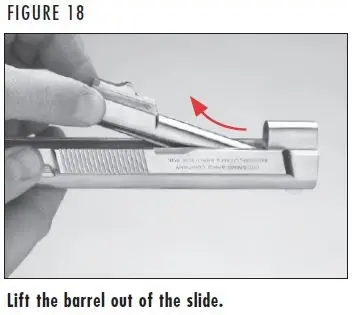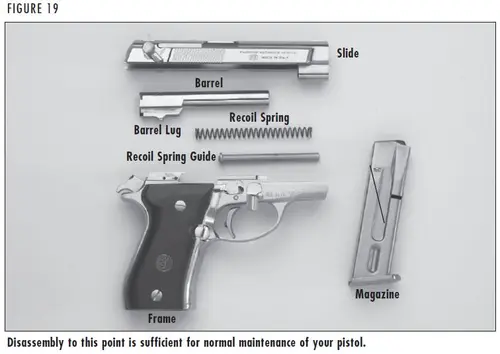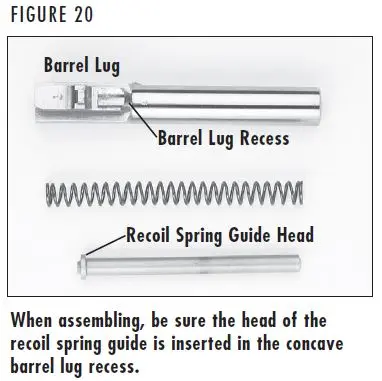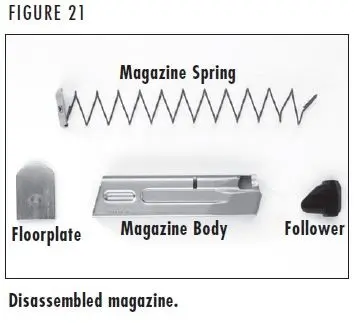Operation and care of
BDA 380 Autoloading Pisol
BDA 380 Autoloading Pisol
THANK YOU FOR CHOOSING A BROWNING BDA 380 AUTOLOADING PISTOL
THANK YOU FOR CHOOSING A BROWNING BDA 380 AUTOLOADING PISTOL
The Browning BDA 380 is a dependable, high-quality centerfire pistol worthy of the Browning name. In every sense, the BDA 380 pistol is a true Browning, giving you the kind of shooting enjoyment and dependability you’ve come to expect from the world’s most respected gun company.
With a reasonable amount of care, your BDA 380 pistol should give you many years of dependable, enjoyable service.
If you have any questions about your new firearm, this owner’s manual or other Browning products, contact:
Browning Customer Service
One Browning Place
Morgan, UT 84050-9326
Phone: (800) 333-3288
browning.com
YOU ARE RESPONSIBLE FOR FIREARMS SAFETY
YOU ARE RESPONSIBLE FOR FIREARMS SAFETY
WARNING: FAILURE TO FOLLOW ANY OF THE FOLLOWING WARNINGS COULD RESULT IN SERIOUS INJURY OR DEATH.
As a gun owner, you accept a set of demanding responsibilities. How seriously you take these responsibilities can be the difference between life and death.
There is no excuse for careless or abusive handling of any firearm. At all times handle this firearm and all other firearms with intense respect for their power and potential danger.
Please read and understand all of the cautions, warnings, notices, proper handling procedures, and instructions outlined in this owner’s manual before using your new firearm.
1 - ALWAYS KEEP THE MUZZLE OF YOUR FIREARM POINTED IN A SAFE DIRECTION EVEN THOUGH YOU ARE CERTAIN IT IS UNLOADED. Never point any firearm at anything you do not intend to shoot. Be extremely alert and aware of all persons and property within the range of your ammunition.
2 - NEVER RELY TOTALLY ON YOUR FIREARM'S MECHANICAL “SAFETY” DEVICE. LIKE ANY MECHANICAL DEVICE, A "SAFETY" CAN SOMETIMES FAIL; IT CAN BE JARRED OR INADVERTENTLY MANIPULATED INTO AN UNSAFE CONDITION. The word, “safety,” describes a firearm’s trigger block mechanism, sear block mechanism, hammer block mechanism, or firing pin block mechanism. Mechanical “safeties” are designed to place your firearm in a safer status, and no guarantee can be made that the firearm will not fire even if the “safety” is in the on safe position. Mechanical “safeties” merely aid safe gun handling and are no excuse for pointing your firearm’s muzzle in an unsafe direction. See “Operation of the Safety” section below for instructions on the operation of this firearm’s “safety.”
Remember, safe gun handling does not stop with your firearm’s mechanical “safety” devices, it starts there. Always treat this firearm with the respect that you would a loaded, ready-to-fire firearm.
Some firearms do not have a mechanical safety. Many target firearms, lever-action firearms, and pistols do not have manual “safety” mechanisms. Therefore it is critical to read and understand the owner’s manual for every firearm which explains the safe operation of the firearm.
While it is a good idea to “test” your firearm’s mechanical “safety” periodically for proper function, never test the “safety” while your firearm is loaded or pointed in an unsafe direction.
3 - WHENEVER YOU HANDLE ANY FIREARM, OR HAND IT TO SOMEONE, ALWAYS OPEN THE ACTION IMMEDIATELY AND VISUALLY CHECK THE FIREARM'S CHAMBER TO MAKE CERTAIN THAT THE FIREARM IS COMPLETELY UNLOADED. Make certain the firearm does not inadvertently contain any ammunition. Remember, merely removing the magazine does not mean the chamber is unloaded. Always keep the chamber empty and the “safety” in the on safe position unless shooting is imminent.
4 - ALWAYS WEAR EAR AND EYE PROTECTION WHEN SHOOTING. Unprotected, repeated exposure to gunfire can cause hearing damage. Wear hearing protection (shooting ear plugs or muffs) to guard against such damage.
Wear shooting glasses to protect your eyes from flying particles. Allow proper distance (eye relief) between a scope and your eye when firing a scoped pistol, rifle, or shotgun. Do not use unorthodox shooting methods that could cause the rearward travel of the slide or bolt of a firearm to contact your eyes, face or hands. Always keep a safe distance between the muzzle of your firearm and any persons nearby, as muzzle blast, debris and ejecting cartridges could inflict serious injury.
Always wear eye protection when disassembling and cleaning any firearm to prevent the possibility of springs, spring-tensioned parts, solvents, or other agents from contacting your eyes visually check the chamber, receiver, and magazine to be certain they do not contain any ammunition.
5 - KEEP ALL FIREARMS UNLOADED DURING TRANSPORT, EVEN WHEN STORED IN A HOLSTER, GUN CASE, SCABBARD, OR OTHER CONTAINER.
6 - DROPPING OR JARRING A LOADED FIREARM CAN CAUSE ACCIDENTAL DISCHARGE. This can occur even with the “safety” in the on safe position. Be extremely careful while hunting or during any shooting activity to avoid dropping any firearm.
7 - HUNTING FROM ELEVATED SURFACES SUCH AS TREESTANDS IS DANGEROUS. Doing so may increase the risk of mishandling a firearm. The following rules should always be observed by you and those you hunt with: Always make certain that the stand being used is safe and stable. Always make certain that your firearm is unloaded when it is being taken up and down from the stand. Always make certain that your firearm is not dropped from the stand, or dropped while it is being taken up or down from the stand. Remember, a loaded firearm may discharge when dropped, even with the “safety” in the on safe position.
8 - STORE YOUR FIREARM AND AMMUNITION SEPARATELY, WELL BEYOND THE REACH OF CHILDREN. Take prudent safeguards to ensure your firearm does not become available to untrained, inexperienced or unwelcome hands. Store all firearms in secure, locked cases or a gun safe. Keep your firearm unloaded when not in use.
9 - BEWARE BARREL OBSTRUCTIONS. Mud, snow and an infinite variety of other objects may inadvertently lodge in a barrel bore. It only takes a small obstruction to cause dangerously increased pressures that can damage your firearm and cause serious injury to yourself and others..
BEFORE CHECKING FOR A BARREL OBSTRUCTION, BE CERTAIN YOUR FIREARM IS COMPLETELY UNLOADED, THERE IS NOT A LIVE CARTRIDGE IN THE CHAMBER AND THE “SAFETY” IS IN THE ON SAFE POSITION.
After assuring yourself that the firearm is completely unloaded, open the breech or action and look through the barrel to be sure it is clear of obstructions. If an obstruction is seen, no matter how small it may be, clean the bore with a cleaning rod and patch as described in the Cleaning and Maintenance section of this owner’s manual.
10 - BE ALERT TO THE SIGNS OF AMMUNITION MALFUNCTION. IF YOU DETECT AN OFF SOUND OR LIGHT RECOIL WHEN A CARTRIDGE IS FIRED, DO NOT LOAD ANOTHER CARTRIDGE INTO THE CHAMBER.
If your firearm fails to fire, keep the muzzle pointed in a safe direction for a minimum of 30 seconds. Rotate the ejection area of the firearm away from you, carefully open the action and remove the cartridge from the chamber. If the primer is indented, the defective cartridge should be disposed of in a way that cannot cause harm. If the primer is not indented, your firearm should be examined by a qualified gunsmith and the cause of the malfunction corrected before further use. Glance down the barrel to make sure that no obstructions remain in the barrel. Completely clear the barrel before loading and firing again. Failure to follow these instructions can cause extensive damage to your firearm and possible serious injury to yourself and others.
11 - NEVER INSERT A CARTRIDGE OF THE INCORRECT CALIBER INTO ANY FIREARM. The caliber of your firearm is marked on the barrel. Store all cartridges of different calibers in completely separate and well-marked containers. Never store cartridges of mixed calibers in a common container or in your pockets. See the ammunition section below for more information on the correct ammunition for your firearm.
12 - EXAMINE EVERY CARTRIDGE YOU PUT IN YOUR FIREARM.
We cannot assume any responsibility for the use of unsafe or improper firearm and ammunition combinations or damage or injury caused by damaged ammunition. It is your responsibility to read and heed all warnings in this owner’s manual and on ammunition boxes. See the ammunition section below for more information on the correct ammunition for your firearm.
13 - USE ONLY SAAMI APPROVED AMMUNITION.
The barrel and action of this firearm have been made with substantial safety margins beyond the pressures developed by established American commercial loads. Nevertheless, we can assume no liability for incidents that occur through the use of cartridges of nonstandard dimensions or which develop pressures in excess of commercially available ammunition which have been loaded in accordance with standards established by the Sporting Arms and Ammunition Manufacturers’ Institute (SAAMI).
14 - MAKE SURE OF ADEQUATE VENTILATION IN THE AREA THAT YOU DISCHARGE A FIREARM. LEAD EXPOSURE CAN OCCUR FROM DISCHARGING FIREARMS IN POORLY VENTILATED AREAS, CLEANING FIREARMS OR HANDLING AMMUNITION.
Lead is a substance that has been known to cause birth defects, reproductive harm, and other serious injury. Wash hands thoroughly after exposure to ammunition or after cleaning a firearm.
15 - DO NOT SNAP THE FIRING PIN ON AN EMPTY CHAMBER, THE CHAMBER MAY NOT BE EMPTY!
Treat every firearm with the respect due a loaded firearm, even though you are certain the firearm is unloaded.
16 - KEEP YOUR FINGERS AWAY FROM THE TRIGGER WHILE LOADING AND UNLOADING UNTIL SHOOTING IS IMMINENT.
17 - BE SURE OF YOUR TARGET AND BACKSTOP, PARTICULARLY DURING LOW LIGHT PERIODS. Know the range of your ammunition. Never shoot at water or hard objects.
18 - ALWAYS UNLOAD YOUR FIREARM'S CHAMBER BEFORE CROSSING A FENCE, CLIMBING A TREE, JUMPING A DITCH OR NEGOTIATING OTHER OBSTACLES. Never place your firearm on or against a fence, tree, car, or other similar object.
19 - BE DEFENSIVE AND ON GUARD AGAINST UNSAFE GUN HANDLING AROUND YOU AND OTHERS. Don’t be timid when it comes to firearm safety. If you observe other shooters violating any of these safety precautions, politely suggest safer handling practices.
20 - BE CERTAIN YOUR FIREARM IS UNLOADED BEFORE CLEANING. Because so many firearm accidents occur when a firearm is being cleaned, special and extreme care should be taken to be sure your firearm is unloaded before disassembly, cleaning, and reassembly. Keep ammunition away from the cleaning location. Never test the mechanical function of any firearm with live ammunition.
21 - TEACH AND SUPERVISE FIREARMS SAFETY TO ALL MEMBERS OF YOUR FAMILY, ESPECIALLY TO CHILDREN AND NON-SHOOTERS. Closely supervise newcomers to the shooting sports. Encourage enrollment in hunting and shooting safety courses.
22 - NEVER DRINK ALCOHOLIC BEVERAGES OR TAKE ANY TYPE OF DRUGS BEFORE OR DURING SHOOTING. Your vision, motor skills, and judgment could be dangerously impaired, making your gun handling unsafe to you and to others.
23 - READ AND HEED ALL WARNINGS IN THIS OWNER'S MANUAL, ON AMMUNITION BOXES, AND WITH ALL ACCESSORIES THAT YOU INSTALL ON YOUR FIREARM. It is your responsibility to secure the most up-to-date information on the safe handling procedures of your Browning firearm. We assume no liability for incidents that occur when unsafe or improper firearm accessories or ammunition combinations are used.
24 - PRACTICE PERIODIC MAINTENANCE, AND AVOID UNAUTHORIZED SERVICING. Your firearm is a mechanical device that will not last forever, and as such, is subject to wear and requires periodic inspection, adjustment and service. Browning firearms should be serviced by a Browning Recommended Service Center or by our Service Facility in Arnold, Missouri. We cannot assume any responsibility for injuries suffered or caused by unauthorized servicing, alterations or modifications of Browning firearms.
25 - WE RESERVE THE RIGHT TO REFUSE SERVICE ON FIREARMS THAT HAVE BEEN ALTERED, ADDED TO OR SUBSTANTIALLY CHANGED. Removal of metal from the barrel, or modifications of the firing mechanism and/or operating parts, may lead to a refusal of service on such firearms. We will charge you for parts and labor to return the firearm to its original specifications.
DO NOT, UNDER ANY CIRCUMSTANCES, ALTER THE TRIGGER, SAFETY OR OTHER PARTS OF THE FIRING MECHANISM OF THIS OR ANY OTHER FIREARM. FAILURE TO OBEY THIS WARNING MAY RESULT IN INJURY OR DEATH TO YOURSELF OR OTHERS..
BE CAREFUL!
BE CAREFUL!
GENERAL DESCRIPTION AND OPERATION
GENERAL DESCRIPTION AND OPERATION
The Browning BDA 380 is a blowback-operated semiautomatic pistol. When fired, the slide is forced rearward by the cartridge pressure and continues rearward travel to accomplish extraction, ejection, and cocking. The recoil spring then causes the slide to travel forward, feeding a loaded cartridge from the magazine and returning the slide and barrel to the firing position. The slide of this pistol is designed to stay open after the last cartridge has been fired and ejected.
NOMENCLATURE
NOMENCLATURE
In conventional firearm terminology, the position and movement of parts are described as they occur with the pistol horizontal and in the normal firing position; i.e. the muzzle is forward or front; the pistol grip is rearward or rear; the trigger is downward or underneath; the sights are upward or on top. For general nomenclature refer to Figure 1.
Serial Number
Serial Number
The serial number of the BDA 380 can be found stamped on the left side of the frame, in front of the trigger guard.
WARNING: ALWAYS KEEP THE “SAFETY” IN THE ON SAFE POSITION UNLESS SHOOTING IS IMMINENT. ALWAYS KEEP THE MUZZLE POINTED IN A SAFE DIRECTION. FAILURE TO FOLLOW THESE WARNINGS COULD RESULT IN SERIOUS INJURY OR DEATH.
OPERATION OF THE “SAFETY” / DECOCKING LEVER
OPERATION OF THE “SAFETY” / DECOCKING LEVER
The ambidextrous, thumb-operated “safety”/decocking lever is located on both sides at the rear of the slide. It can be conveniently operated by a left- or right-handed shooter. Both levers are serrated for more positive manipulation.
NOTICE! BECAUSE THE “SAFETY” IS ALSO THE DECOCKING LEVER, SPECIAL ATTENTION MUST BE GIVEN TO THE POSITION OF THE LEVER WHEN CLOSING THE SLIDE. FAILURE TO PLACE THE SAFETY IN THE OFF SAFE POSITION PRIOR TO CLOSING THE SLIDE MAY RESULT IN DAMAGE TO THE DECOCKING SYSTEM. WHEN DECOCKING THE HAMMER, ALWAYS MAKE SURE YOUR PISTOL IS POINTED IN A SAFE DIRECTION.
MANUAL “SAFETY” FUNCTION
On Safe: To place the pistol in the on safe position, press the “safety”/decocking lever fully downward with your thumb (Figure 2). When the “safety”/decocking lever is pressed fully downward, the hammer will move to the decocked position (if it was in full cock position when safety was pressed down).
Off Safe: To place the “safety” in the off safe or ready-to-fire position, press the “safety”/decocking lever forward and up, exposing the red warning dot. The red warning dot appears on both sides of the slide (Figure 3).
WARNING: DO NOT DEPEND ON THE RED COLOR ALONE TO INDICATE YOUR FIREARM’S SAFETY STATUS. TIME, EXPOSURE TO THE ELEMENTS, AND THE ABRASIVE ACTION OF CLEANING AGENTS CAN ERASE IT. FAILURE TO FOLLOW THIS WARNING COULD RESULT IN SERIOUS INJURY OR DEATH.
With a cartridge in the chamber and the magazine inserted, the pistol is now ready for firing with a pull on the trigger.
IMPORTANT: This pistol cannot be on safe with the hammer in the full cock position because the “safety” is also the decocking lever, and depressing the “safety”/decocking lever will cause the hammer to move to the decocked position (if the hammer was cocked before you placed the pistol on safe). This requires firm pressure on the “safety”/decocking lever. Do not press the “safety”/decocking lever partially downward, leaving the hammer in the full cock position, and assume the pistol is on safe. If the hammer does not move from the full cock position to the decocked position, the “safety”/decocking lever is not in the on safe position. Additionally, the hammer cannot be cocked with the “safety”/decocking lever in the on safe position.
DECOCKING LEVER FUNCTION
The “safety”/decocking lever also functions as a decocking lever to provide a safer method of lowering the hammer from full cock to the decocked position without having to depress the trigger. With the muzzle pointed in a safe direction and your finger away from the trigger, simply depress the “safety”/decocking lever fully down with your thumb (Figure 4). The hammer will lower to the decocked position.
WARNING: DO NOT ATTEMPT TO MOVE THE HAMMER TO THE DECOCKED POSITION BY PULLING THE TRIGGER AND LOWERING THE HAMMER WITH YOUR THUMB AS WITH SOME OTHER STYLES OF FIREARMS. YOUR THUMB MAY SLIP AND CAUSE THE PISTOL TO FIRE, POSSIBLY CAUSING INJURY OR DEATH.
THE HAMMER SHOULD ONLY BE LOWERED TO THE DECOCKED POSITION USING THE “SAFETY”/DECOCKING LEVER. WHEN DECOCKING THE HAMMER, ALWAYS MAKE SURE YOUR PISTOL IS POINTED IN A SAFE DIRECTION AND KEEP YOUR FINGERS AWAY FROM THE TRIGGER. ALWAYS BE SURE TO FULLY DEPRESS THE “SAFETY”/DECOCKING LEVER TO LOWER THE HAMMER FROM THE FULL COCK TO THE DECOCKED POSITION. BE SURE THE HAMMER MOVES COMPLETELY TO THE DECOCKED POSITION.
OPERATION OF THE HAMMER
OPERATION OF THE HAMMER
The BDA 380 has an exposed hammer with dropped, decocked, and full cock positions. In order for the trigger to operate the hammer, the magazine must be inserted in the pistol.
DROPPED POSITION
This is the momentary position of the hammer after the trigger is pulled (Figure 5) when dry firing or if a cartridge failed to fire in the chamber. In the dropped position, the hammer is fully fallen and resting against the inertia firing pin, but the firing pin is not in contact with the cartridge primer. (The firing pin must be struck forcefully by the hammer in order to achieve enough momentum to contact and indent the primer, causing cartridge ignition.)
DECOCKED POSITION
The decocked hammer position is between the dropped and full cock position (Figure 6). This is the position the hammer should be located in at all times when carrying or storing your pistol. The decocked position is provided as the primary, safest location of the hammer any time the slide is closed.
FULL COCK POSITION
When at full cock, the hammer is all the way to the rear (Figure 7). In the full cock position, with the “safety”/decocking lever in the off safe position, and with a cartridge in the chamber, the pistol is ready to fire by pulling the trigger.
SLIDE RELEASE / STOP LATCH
SLIDE RELEASE / STOP LATCH
With an empty magazine inserted, the slide can be “locked” rearward simply by grasping the slide serrations immediately forward of the “safety”/decocking lever and drawing the slide fully rearward until the slide release/stop latch automatically rotates upward into its appropriate recess. (If an empty magazine is not inserted, the slide release/stop latch must be manually pushed upward into its recess in the slide.) After the last shot has been fired from the magazine the slide will “lock” rearward. This position is an additional safety measure and allows easy inspection of the barrel chamber.
To close the slide, be certain the “safety”/decocking lever is in the off safe position and your fingers are away from the ejection port and trigger. With the muzzle of the pistol pointed in a safe direction, simply depress the slide release/stop latch located on the left side of the frame (Figure 8).
WARNING: MAKE SURE YOUR FINGERS ARE SAFELY AWAY FROM THE CHAMBER WHEN THE SLIDE IS RELEASED TO AVOID PINCHING THEM WHEN THE SLIDE CLOSES.
NOTICE! FAILURE TO PUT THE “SAFETY”/DECOCKING LEVER IN THE OFF SAFE POSITION WHILE CLOSING THE SLIDE MAY CAUSE DAMAGE TO THE DECOCKING SYSTEM. AFTER CLOSING THE SLIDE, BE CERTAIN THE
“SAFETY”/DECOCKING LEVER IS MOVED TO THE “ON SAFE” POSITION, WHICH WILL ALSO DECOCK THE HAMMER. WHEN DECOCKING THE HAMMER, ALWAYS MAKE SURE YOUR PISTOL IS POINTED IN A SAFE DIRECTION.
LOADED CHAMBER INDICATOR
LOADED CHAMBER INDICATOR
Always assume that the chamber of your BDA 380 is loaded. The loaded chamber indicator is to be used only to confirm or verify that a cartridge is in the chamber. In any situation, to use the loaded chamber indicator, (1) shooting should be imminent, (2) you have already loaded the chamber, and (3) you are in a situation where it is an advantage to confirm that the chamber is loaded. Never use the loaded chamber indicator to determine whether the chamber is loaded or not.
When there is a cartridge in the chamber, the forward portion of the extractor will cam outward slightly, exposing a red index mark. This index mark is located on the top, forward surface of the extractor.
The extractor is a slender bar, about 11⁄4" long, located on the right side of the slide immediately behind the ejection port (Figure 9). With practice, the protrusion can be both seen and felt.
WARNING: THE LOADED CHAMBER INDICATOR IS ONLY FOR CONFIRMING THAT A CARTRIDGE IS IN THE CHAMBER WHEN SHOOTING IS IMMINENT. IT IS NEVER A REPLACEMENT FOR CHECKING THE LOADED STATUS OF YOUR PISTOL BY OPENING THE ACTION AND REMOVING ALL CARTRIDGES FROM THE CHAMBER AND MAGAZINE.
WHENEVER USING THE LOADED CHAMBER INDICATOR TO CONFIRM THAT YOUR PISTOL’S CHAMBER IS LOADED, ALWAYS FIRST MAKE SURE THE BARREL IS POINTED IN A SAFE DIRECTION AND THAT THE “SAFETY”/DECOCKING LEVER IS IN THE ON SAFE POSITION. DO NOT USE THESE INDICATORS WITH LIVE AMMUNITION UNLESS AT AN APPROPRIATE SHOOTING LOCATION AND WHEN ALL SAFETY RULES ARE ADHERED TO.
DO NOT DEPEND ON THE RED COLOR ALONE TO INDICATE YOUR FIREARM’S SAFETY STATUS. TIME, EXPOSURE TO THE ELEMENTS, AND THE ABRASIVE ACTION OF CLEANING AGENTS CAN ERASE IT.
FAILURE TO FOLLOW THESE WARNINGS COULD RESULT IN SERIOUS INJURY OR DEATH.
INITIAL CLEANING
INITIAL CLEANING
CLEANING
Various exposed metal parts of your new firearm have been coated at the factory with a rust preventative compound. Before firing your pistol, clean the anti-rust compound from the inside of the barrel, receiver and the action-chamber areas. A fine, light gun oil is ideal for removing this compound and for giving your new firearm its first lubrication. However, any quality firearm oil may be used. Clean the barrel using a cleaning rod and patch as explained under “Cleaning and Maintenance Suggestions” on page 28. If your pistol is to be stored, it is acceptable to leave the rust preventative compound on the pistol and keep it in its original packaging.
NOTICE! THIS IS A SPECIALIZED, FINELY FITTED MECHANISM. DO NOT TAKE YOUR FIREARM’S ACTION APART BEYOND WHAT IS EXPLAINED IN THIS OWNER’S MANUAL. IT IS UNNECESSARY, AND MAY PERMANENTLY DAMAGE THE INNER MECHANISM OR RENDER THE FIREARM UNSAFE TO DISASSEMBLE IT FOR ROUTINE CLEANING AND OILING. OF COURSE, MISFORTUNES (SUCH AS DROPPING YOUR GUN IN WATER) REQUIRE APPROPRIATE ATTENTION, AND IN SUCH CIRCUMSTANCES WE RECOMMEND YOU IMMEDIATELY TAKE YOUR FIREARM TO A QUALIFIED GUNSMITH.
WARNING: BDA 380 PISTOLS ARE CHAMBERED FOR .380 AUTO CARTRIDGES ONLY. DO NOT USE AMMUNITION OTHER THAN WHAT IS INSCRIBED ON THE EXPOSED PORTION OF THE BARREL. EXAMINE EVERY CARTRIDGE YOU PUT IN YOUR BDA 380.
AMMUNITION
AMMUNITION
The barrel and action of this pistol have been made with substantial safety margins over the pressures developed by established American loads. However, we assume no responsibility for incidents which occur through the use of cartridges of nonstandard dimension or those developing pressures in excess of SAAMI (Sporting Arms and Ammunition Manufacturers' Institute) established standards.
MAGAZINE CAPACITY
MAGAZINE CAPACITY
BDA 380 pistols have a magazine capacity of 13 rounds plus one in the chamber, for a total capacity of 14 rounds. However, some states limit the magazine capacity to 10 rounds plus one in the chamber, for a total capacity of 11 rounds. All BDA 380 pistols sold in these states will be shipped with reduced total magazine capacity in compliance with state law.
IMPORTANT: Current 13-round magazines will have a “13” stamped under the lowest index hole on the back of the magazine. 10-round magazines can be identified by the number “10” stamped below the lowest hole (Figure 10). Make sure you verify the capacity of the magazine before loading it in your pistol.
WARNING: WHEN LOADING YOUR PISTOL ALWAYS KEEP THE MUZZLE POINTED IN A SAFE DIRECTION, THE “SAFETY” IN THE ON SAFE POSITION, AND YOUR FINGERS AWAY FROM THE TRIGGER. FAILURE TO FOLLOW THESE WARNINGS COULD RESULT IN SERIOUS INJURY OR DEATH.
LOADING
LOADING
REMOVING AND LOADING THE MAGAZINE
1. Close the slide and place the “safety”/decocking lever in the on safe position.
2. Press the magazine release on the left side of the frame at the rear of the trigger guard and remove the magazine (Figure 11). As a precaution, pull the slide rearward and visually inspect the chamber to eliminate any possibility of a cartridge being in the chamber. Close the slide. Remember the “safety”/decocking lever must be in the off safe position to prevent damage to the decocking system.
3. Insert the cartridges into the magazine by pushing downward on the front of the follower with the base of the cartridge and then pushing the cartridge rearward under the feed lips on the magazine with your thumb (Figure 12).
LOADING THE CHAMBER WITH THE SLIDE CLOSED
1. Insert the loaded magazine into the pistol. Be certain to insert the magazine completely and it is retained by the magazine latch.
2. Slide the “safety”/decocking lever up into the off safe position.
3. Pull the slide completely back and release the slide. It will move forward under spring pressure and feed the first cartridge from the magazine into the chamber.
WARNING: THE PISTOL IS NOW READY TO FIRE. UNLESS SHOOTING IS IMMINENT, IMMEDIATELY RETURN THE “SAFETY” TO THE ON SAFE POSITION. FAILURE TO FOLLOW THESE WARNINGS COULD RESULT IN SERIOUS INJURY OR DEATH.
4. Immediately place the “safety”/decocking lever in the on safe position (which will also decock the hammer) after feeding a cartridge unless shooting is imminent.
LOADING THE CHAMBER WITH THE SLIDE LOCKED REARWARD
The slide of the BDA 380 locks rearward after the last cartridge from the magazine is fired. If you are shooting in competitive matches or for law enforcement purposes, and shooting after firing an entire magazine is imminent, it is possible to reload the pistol with the slide locked rearward and chamber a cartridge when the slide is closed.
WARNING: UNDER MOST CONDITIONS YOU SHOULD IMMEDIATELY REMOVE THE EMPTY MAGAZINE, CLOSE THE SLIDE AND PLACE THE “SAFETY”/DECOCKING LEVER IN THE “ON SAFE” POSITION PRIOR TO INSERTING A LOADED MAGAZINE INTO THE PISTOL. UNDER SPECIAL LAW ENFORCEMENT AND COMPETITIVE SHOOTING CONDITIONS, YOU CAN LEAVE THE SLIDE OPEN AFTER THE EMPTY MAGAZINE IS REMOVED. FAILURE TO FOLLOW THESE WARNINGS COULD RESULT IN SERIOUS INJURY OR DEATH.
1. With the slide locked rearward, eject the empty magazine from the pistol.
2. Insert a loaded magazine into the pistol.
3. Release the slide forward by pushing downward on the slide stop / release lever with your thumb. The slide will close under spring pressure and feed a cartridge from the magazine into the chamber. Remember the “safety”/decocking lever must be in the off safe position to prevent damage to the decocking system.
WARNING: THE PISTOL IS NOW READY TO FIRE. UNLESS SHOOTING IS IMMINENT, IMMEDIATELY RETURN THE “SAFETY” TO THE ON SAFE POSITION. FAILURE TO FOLLOW THESE WARNINGS COULD RESULT IN SERIOUS INJURY OR DEATH.
4. If shooting is no longer imminent, point the muzzle in a safe direction and immediately push the “safety”/decocking lever downward, decocking the hammer and placing the “safety”/decocking lever in the on safe position. The pistol can then be fired in double-action mode by moving the “safety”/decocking lever upward to the off safe position and squeezing the trigger.
When you are finished shooting, the loaded cartridge should be removed from the chamber as explained under the “Unloading” section below.
WARNING: NEVER CHAMBER A CARTRIDGE OR MOVE THE “SAFETY” FROM THE ON SAFE POSITION UNLESS SHOOTING IS IMMINENT. ALWAYS KEEP THE MUZZLE POINTED IN A SAFE DIRECTION. FAILURE TO FOLLOW THESE WARNINGS COULD RESULT IN SERIOUS INJURY OR DEATH.
DO NOT USE UNORTHODOX SIGHTING METHODS. YOU WILL HAVE OBSERVED WHEN COCKING THE PISTOL THAT THE SLIDE MOVES REARWARD ABOUT 3⁄4" PAST THE REAR OF THE FRAME (FIGURE 13). TO PREVENT THE SLIDE FROM CAUSING INJURY IN ITS REARWARD MOVEMENT WHEN YOU ARE SHOOTING, KEEP THE PISTOL AWAY FROM THE EYES OR FACE, AND NEITHER HAND SHOULD BE IN A POSITION WHERE IT COULD BE HIT BY THE SLIDE.
FIRING
FIRING
DOUBLE-ACTION FIRING
1. Load a cartridge into the chamber as explained previously. Immediately place the “safety”/decocking lever in the on safe position.
2. With a cartridge in the chamber, you need only move the “safety”/decocking lever to the off safe position to make the pistol ready for firing.
3. When ready to fire, move the “safety”/decocking lever up into the off safe position, take aim and squeeze the trigger.
IMPORTANT: The trigger pull is significantly longer and heavier when firing from the double-action, decocked hammer position. After the pistol has been fired, the hammer remains in the full cock position and the trigger pull is shorter and lighter. Always know the position of your hammer.
4. After a cartridge has been fired, the slide moves rearward, ejects the empty case, then returns forward, loading a cartridge from the magazine. You may continue to fire the pistol until the magazine is empty by pulling the trigger to fire each cartridge.
After the last cartridge in the magazine is fired, the slide release/stop latch automatically holds the slide in its open or rearward position. If firing is no longer imminent, close the slide by pushing down on the slide release/stop latch, remove the magazine and place the “safety”/decocking lever in the on safe position.
WARNING: AFTER THE LAST CARTRIDGE HAS BEEN FIRED, OR WHEN SHOOTING IS NO LONGER IMMINENT, IMMEDIATELY PLACE THE “SAFETY” IN THE ON SAFE POSITION. FAILURE TO FOLLOW THESE WARNINGS COULD RESULT IN SERIOUS INJURY OR DEATH.
5. If the magazine is empty and you wish to continue shooting, follow the instructions in “Loading” on page 17. If you are finished shooting, follow the instructions in the “Unloading” section below.
When reloading the pistol, it is recommended that you inspect the chamber to be sure it is empty, then close the slide and place the manual thumb “safety”/decocking lever in the on safe position prior to inserting a loaded magazine into the pistol. To reduce the chance of inadvertently feeding a cartridge into the chamber from the magazine, always remove the empty magazine, close the slide using the slide release/stop latch and place the “safety”/decocking lever in the on safe position before inserting a loaded magazine.
If your pistol is to be put away and stored, do not insert a loaded magazine in the pistol. The chamber and magazine should remain empty.
SINGLE-ACTION FIRING
If you wish to fire the first cartridge single-action instead of double- action, simply raise the “safety”/decocking lever to the off safe position and cock the hammer with your thumb. Be sure the muzzle is pointed in a safe direction and your finger is away from the trigger when cocking the hammer. The first shot is now ready to fire simply by pulling the trigger as long as the magazine is in the pistol.
WARNING: WHEN THE HAMMER IS AT FULL COCK THE TRIGGER PULL IS SIGNIFICANTLY SHORTER AND LIGHTER THAN WHEN PULLING THE TRIGGER FROM THE DECOCKED POSITION. ALWAYS TAKE SPECIAL CARE TO KNOW THE STATUS OF YOUR PISTOL’S HAMMER. FAILURE TO FOLLOW THESE WARNINGS COULD RESULT IN SERIOUS INJURY OR DEATH.
WARNING: WHILE UNLOADING YOUR PISTOL ALWAYS KEEP THE MUZZLE POINTED IN A SAFE DIRECTION, AND YOUR FINGERS AWAY FROM THE TRIGGER. FAILURE TO FOLLOW THESE WARNINGS COULD RESULT IN SERIOUS INJURY OR DEATH.
UNLOADING
UNLOADING
UNLOADING THE PISTOL
1. Depress the magazine release and remove the magazine. Remember, merely removing the magazine does not mean the chamber is unloaded.
2. Slide the manual thumb “safety” up into the off safe position.
3. Pull back on the slide and eject the cartridge in the chamber. Lock the slide to the rear by sliding the slide release/stop latch up.
4. Inspect the chamber to ensure no cartridge is present.
5. When you are certain your pistol is fully unloaded, push down on the slide release/stop latch and allow the slide to return forward.
6. Place the “safety”/decocking lever in the on safe position.
UNLOADING THE MAGAZINE
1. Depress the magazine release and remove the magazine. Remember, merely removing the magazine does not mean the chamber is unloaded.
2. Unload the pistol as explained previously, make sure the chamber is completely unloaded.
3. Strip the cartridges from the magazine by pushing forward on the rim of the top cartridge and sliding each cartridge out, one at a time, as each moves up in the magazine.
4. Unload any extra magazines.
WARNING: BEFORE PERFORMING SIGHT ADJUSTMENT PROCEDURES, PLACE THE “SAFETY” IN THE ON SAFE POSITION. REMOVE THE MAGAZINE FROM THE FIREARM AND ENSURE THE CHAMBER IS COMPLETELY UNLOADED. ALWAYS KEEP THE MUZZLE POINTED IN A SAFE DIRECTION. FAILURE TO FOLLOW THESE WARNINGS COULD RESULT IN SERIOUS INJURY OR DEATH.
SIGHT ADJUSTMENT
SIGHT ADJUSTMENT
The BDA 380 is equipped with a fixed front sight blade and a windage adjustable rear sight. No adjustment of the front sight is necessary. Sight adjustment is a process of trial and error using the method described on the page below.
The windage adjustment (horizontal correction) is preset at the factory. However, should adjustment be required, the rear sight may be moved in the dovetail slot in the slide. This is accomplished by lightly tapping the base of the rear sight using a small wooden dowel or comparable nonmetallic object against the sight base when tapping to avoid marring the finish (Figure 14).
Tap the sight base in the same direction you want the bullet impact to move; i.e., if you want the point of impact to move to the left, tap the rear sight to the left; if you want to move the point of impact to the right, tap the rear sight to the right.
WARNING: BEFORE PERFORMING DISASSEMBLY PROCEDURES, PLACE THE “SAFETY” IN THE ON SAFE POSITION. REMOVE THE MAGAZINE FROM THE FIREARM AND ENSURE THE CHAMBER IS COMPLETELY UNLOADED. ALWAYS KEEP THE MUZZLE POINTED IN A SAFE DIRECTION. FAILURE TO FOLLOW THESE WARNINGS COULD RESULT IN SERIOUS INJURY OR DEATH.
WEAR EYE PROTECTION WHEN DISASSEMBLING AND CLEANING YOUR PISTOL TO PREVENT THE POSSIBILITY OF SPRINGS, SPRING-TENSIONED PARTS, SOLVENTS OR OTHER AGENTS FROM CONTACTING YOUR EYES RESULTING IN INJURY.
KEEP ALL AMMUNITION AWAY FROM THE CLEANING AREA. NEVER TEST THE MECHANICAL FUNCTION OF YOUR PISTOL WITH LIVE AMMUNITION.
DISASSEMBLY
DISASSEMBLY
FAILURE TO FOLLOW THESE WARNINGS COULD RESULT IN SERIOUS INJURY OR DEATH.
1. Be sure the “safety”/decocking lever is in the on safe position.
2. Remove the magazine as explained under the “Unloading” section below and visually inspect the chamber to ensure no cartridge remains.
3. Lock the slide rearward by pulling the slide back and engaging the slide stop/release latch into the disassembly recess on the slide (Figure 15).
4. Depress the takedown lever stop (Figure 16). This is the small, button-like part that extends out of the frame just forward of the slide stop/release lever. The takedown lever stop passes through the frame of the pistol from the left to the right side. The takedown lever (on the right side) will not rotate unless the takedown lever stop is pushed in (on the left side), releasing the lever to rotate. With the button depressed, rotate the takedown lever on the right side of the frame counterclockwise 90 degrees downward (Figure 17).
5. Place the “safety”/decocking lever in the “off safe” position.
6. While holding the frame with one hand, and the slide with the other hand, pull the slide rearward slightly to release the slide release/stop latch, then guide the slide forward off the frame. The slide will be under spring pressure for part of its travel. Carefully push it the rest of the way off the frame.
7. Push the slide forward on the frame rails until the slide is completely removed from the frame.
8. While holding the slide, press the head of the recoil spring guide forward to release the head of the recoil spring guide from the barrel. Remove the recoil spring and its guide.
9. To remove the barrel from the slide, lift up the barrel lug and slide the barrel out rearward (Figure 18). Disassembly to this point is sufficient for normal maintenance of your pistol (Figure 19).
No further disassembly is recommended as the pistol is now stripped adequately for normal maintenance and cleaning.
IF FURTHER DISASSEMBLY SHOULD EVER BECOME NECESSARY IT SHOULD ONLY BE PERFORMED BY OUR SERVICE FACILITY IN ARNOLD, MISSOURI, OR AN AUTHORIZED BROWNING SERVICE CENTER. NO OTHER PERSON SHOULD ATTEMPT TO PERFORM FURTHER DISASSEMBLY/REASSEMBLY PROCEDURES. INCORRECT REASSEMBLY COULD RENDER THE FIREARM INOPERATIVE OR UNSAFE. FAILURE TO FOLLOW THIS INSTRUCTION CAN RESULT IN DAMAGE TO YOUR GUN AND POSSIBLE SERIOUS INJURY OR DEATH TO YOURSELF AND OTHERS.
ASSEMBLY
ASSEMBLY
1. Replace the barrel into the slide.
2. Replace the recoil spring and guide into the slide. The head of the recoil spring guide is positioned rearward. Compress the recoil spring by pushing on the head of the guide until the head of the guide can be inserted in the concave recess of the barrel lug (Figure 20).
3. Replace the slide on the frame and hold it fully rearward. Lock the slide rearward by moving the slide stop/release latch upward into the notch in the slide.
4. Depress the takedown lever stop and rotate the takedown lever clockwise rearward and upward 90 degrees. Be sure the barrel is in its most rearward position. Note: If the takedown lever has been removed for any reason, be sure to replace it prior to closing the slide. Failure to do so will cause the slide assembly to eject off the front of the pistol.
5. Release the slide by depressing the slide stop/release latch.
6. Place the “safety”/decocking lever in the on safe position. This will also decock the hammer.
7. Replace the magazine, or leave it out if you are storing your pistol or performing other maintenance.
WARNING: BEFORE PERFORMING CLEANING PROCEDURES, PLACE THE “SAFETY” IN THE ON SAFE POSITION. REMOVE THE MAGAZINE FROM THE FIREARM AND ENSURE THE CHAMBER IS COMPLETELY UNLOADED. ALWAYS KEEP THE MUZZLE POINTED IN A SAFE DIRECTION. FAILURE TO FOLLOW THESE WARNINGS COULD RESULT IN SERIOUS INJURY OR DEATH.
WEAR EYE PROTECTION WHEN DISASSEMBLING AND CLEANING YOUR PISTOL TO PREVENT THE POSSIBILITY OF SPRINGS, SPRING-TENSIONED PARTS, SOLVENTS OR OTHER AGENTS FROM CONTACTING YOUR EYES, RESULTING IN INJURY.
KEEP ALL AMMUNITION AWAY FROM THE CLEANING AREA. NEVER TEST THE MECHANICAL FUNCTION OF YOUR PISTOL WITH LIVE AMMUNITION. FAILURE TO FOLLOW THESE WARNINGS COULD RESULT IN SERIOUS INJURY OR DEATH.
CLEANING AND MAINTENANCE SUGGESTIONS
CLEANING AND MAINTENANCE SUGGESTIONS
CLEANING PROCEDURES
Your BDA 380 will function better and more reliably over a longer period of time if it is properly maintained and kept clean.
Clean your BDA 380 after every day of shooting, and more often if it becomes excessively dirty. A minimum cleaning includes wiping down the action and oiling key parts. Most regular maintenance will also include cleaning the barrel. If you encounter a function problem be sure to clean your firearm thoroughly to see if it solves the problem before seeking the services of a Browning Recommended Service Center or our Service Facility in Arnold, Missouri, or a qualified gunsmith.
1. Disassemble the pistol as described on above
2. Inspect the chamber and bore for powder fouling. A normal amount of powder residue can be expected and is not serious. It can usually be removed with a patch saturated with nitro solvent. Clean the bore using an appropriate pistol cleaning rod with a tip and patch of the correct caliber to provide a snug fit in the bore. Insert the rod and patch into the barrel at the breech end and run it back and forth several times. Care should be exercised to ensure that the cleaning rod does not strike the crown of the muzzle, as damage to this area can affect the accuracy of your pistol. If, or when, fouling should become heavy, it can be removed with a bronze bore brush. Dip or spray the brush with nitro solvent and scrub the chamber and bore until the fouling is removed. To prevent bronze bristles from breaking off, the brush should be pushed completely through the barrel before being withdrawn.
To maintain the utmost accuracy of your pistol it is recommended you clean the bore with a copper solvent. Modern bullet jackets are made mainly of copper. Residues from copper bullet jackets stick to the barrel and require more frequent cleaning. Swab the bore with a quality copper solvent using the manufacturer’s recommended procedure.
3. After all fouling has been removed, the chamber and bore should be wiped dry. When the bore is dry, pass a slightly oiled patch through it for preservation. A fine, light gun oil is recommended.
4. Inspect the barrel and chamber to be certain no patches have inadvertently been left in them. Remove any that remain.
5. Use a small brush or rag to remove dirt or other foreign matter from the slide and other parts of the action. Lightly lubricate all moving parts with a high-quality, light gun oil.
IMPORTANT: Lightweight oils may evaporate. If your BDA 380 has been stored for any length of time, completely lubricate before shooting.
NOTICE! DO NOT PLACE LARGE QUANTITIES OF OIL INTO THE ACTION. EXCESS OIL WILL RUN BACK INTO THE GRIPS AND SOFTEN THE WOOD, WITH CONSEQUENTIAL LOOSENING OF THE GRIPS.
6. Wipe all exposed metal surfaces with a lightly oiled cloth making certain that all finger marks are removed. Finger marks provide a place where moisture can accumulate. The metal should receive a light film of oil any time the pistol has been exposed to weather or handling.
7. The wood grips can also be wiped with a quality, lightweight gun oil or polished with any quality furniture wax (but not both).
NOTICE! DO NOT USE EXCESSIVE LUBRICANT. USING TOO MUCH LUBRICANT CAN INTERFERE WITH THE FUNCTIONING OF YOUR PISTOL.
CLEANING THE MAGAZINE
CLEANING THE MAGAZINE
Frequently inspect magazines to determine the need for cleaning as lubricant and dirt will gradually collect in the mechanism. Normally, the magazine should be cleaned after firing 500 to 1000 cartridges.
Disassembly takes just a few seconds and should be a normal part of your pistol’s maintenance. Component parts are designed for ease of disassembly and reassembly (Figure 21). This gives you extra confidence when conducting maintenance in the field.
MAGAZINE DISASSEMBLY
1. Use a thin screw driver or other suitable object to release the floorplate from the magazine by pressing the release button through the hole in the bottom of the floorplate.
2. With the “button” pressed, slide the floorplate forward and off the rails.
WARNING: WEAR EYE PROTECTION WHEN DISASSEMBLING AND CLEANING YOUR PISTOL TO PREVENT THE POSSIBILITY OF SPRINGS, SPRING-TENSIONED PARTS, SOLVENTS OR OTHER AGENTS FROM CONTACTING YOUR EYES, RESULTING IN INJURY.
3. Carefully remove the magazine spring. The floorplate retainer will usually stay connected to the spring. Note its position. Be prepared to retain the spring, as it is compressed and may spring out unless controlled.
4. Allow the spring assembly to release its tension, then remove the spring from the magazine body.
5. Remove the follower from the magazine body. Note its position.
6. Perform any cleaning and maintenance as outlined in the section “Cleaning and Maintenance Suggestions” above.
MAGAZINE REASSEMBLY
1. Position the follower on the spring with the notch in the top of the follower upward. The follower will fit into the top coil of the spring at about a 45-degree angle. The notched end of the follower will be toward the top.
2. Insert the spring assembly (with the follower attached) into the magazine body. Make sure that the notched (or upper) part of the follower is facing toward the front of the magazine. Leave the spring out, decompressed at this time.
3. Make sure the floorplate retainer is attached to the magazine spring. Insert the end of the spring through the keeper on the floorplate retainer: round edge to the front, release button downward.
4. Push the spring and retainer the rest of the way into the magazine body. Be very careful. The spring is under tension and will spring out.
5. Hold the retainer down, inside the magazine with one hand while you slide the floorplate onto the rails, starting the floorplate at the front of the magazine body and sliding it rearward, until the floorplate retainer snaps into position. The shape of the floorplate corresponds to the shape of the floorplate retainer and the overall shape of the bottom of the magazine body with the rounded edges to the front, flat edges to the rear.
NOTICE! THIS IS A SPECIALIZED, FINELY FITTED MECHANISM. DO NOT TAKE YOUR FIREARM’S ACTION APART BEYOND WHAT IS EXPLAINED IN THIS OWNER’S MANUAL. IT IS UNNECESSARY, AND MAY PERMANENTLY DAMAGE THE INNER MECHANISM OR RENDER THE FIREARM UNSAFE TO DISASSEMBLE IT FOR ROUTINE CLEANING AND OILING. OF COURSE, MISFORTUNES (SUCH AS DROPPING YOUR GUN IN WATER) REQUIRE APPROPRIATE ATTENTION, AND IN SUCH CIRCUMSTANCES WE RECOMMEND YOU IMMEDIATELY TAKE YOUR FIREARM TO A QUALIFIED GUNSMITH.
SERVICE OR REPAIR
SERVICE OR REPAIR
If your firearm should require service or repairs, we suggest you first contact a local recommended Browning Firearms Service Center.
To locate a service center visit browning.com, contact our Customer Service Department or your Browning firearms dealer for the address of the Service Center nearest you. Otherwise, you may send your firearm directly to our Service Department in Arnold, Missouri.
Parts listings, Firearm Service Center lists, service procedures, service/repair form and general product information are also found on the internet at: browning.com. For technical questions about your firearm or service, contact:
United States customers contact:
Browning Firearm Status and Technical Service
One Browning Place
Arnold, MO 63010-9406
Phone: (800) 322-4626
Canadian customers contact:
Browning Canada Sports Ltd/Ltée
5583 Chemin St-François
St-Laurent, Quebec H4S 1W6
Phone: (514) 333-7261
When returning your firearm for servicing, you must do the following:
1. Be sure it is completely unloaded.
2. Remove the scope or other optics.
3. Package it securely in a cardboard container.
4. Enclose the service/repair form available at browning.com or a letter that clearly describes the trouble experienced, the ammunition used and the repairs desired. Also include your name, email address (if possible) and a daytime phone number where you can be reached.
5. If convenient, send a copy of the service/repair form or letter to us separately.
6. Never return ammunition with your firearm. It is against postal and most commerce regulations.



